Related Research Articles
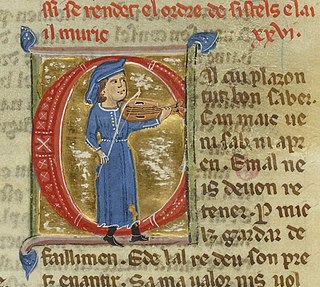
A troubadour was a composer and performer of Old Occitan lyric poetry during the High Middle Ages (1100–1350). Since the word troubadour is etymologically masculine, a female troubadour is usually called a trobairitz.
Occitan literature is a body of texts written in Occitan, mostly in the south of France. It was the first literature in a Romance language and inspired the rise of vernacular literature throughout medieval Europe. Occitan literature's Golden Age was in the 12th century, when a rich and complex body of lyrical poetry was produced by troubadours writing in Old Occitan, which still survives to this day. Although Catalan is considered by some a variety of Occitan, this article will not deal with Catalan literature, which started diverging from its Southern French counterpart in the late 13th century.

Peire Cardenal was a troubadour known for his satirical sirventes and his dislike of the clergy. Ninety-six pieces of his remain, a number rarely matched by other poets of the age.
Trobar clus, or closed form, was a complex and obscure style of poetry used by troubadours for their more discerning audiences, and it was only truly appreciated by an elite few. It was developed extensively by Marcabru and Arnaut Daniel, but by 1200 its inaccessibility had led to its disappearance. Among the imitators of Marcabru were Alegret and Marcoat, who claimed himself to write vers contradizentz, indicative of the incomprehensibility of the trobar clus style. Below is a sample of the style from Marcoat's sirventesMentre m'obri eis huisel, wherein the poet himself remarks on his moz clus :
Pierre Bec was a French Occitan-language poet and linguist. Born in Paris, he spent his childhood in Comminges, where he learnt Occitan. He was deported to Germany between 1943 and 1945. After returning, he studied in Paris, where he graduated in 1959. He was one of the founders of the IEO or Institut d'Estudis Occitans as well as its president from 1962 to 1980.

Pons de Capduelh was a troubadour from the Auvergne, probably from Chapteuil. His songs were known for their great gaiety. He was a popular poet and 27 of his songs are preserved, some in as many as 15 manuscripts. Four of his cansos survive with musical notation.
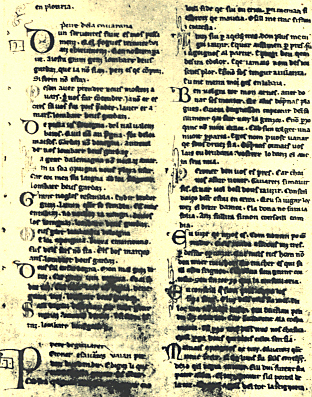
Peire de la Caravana was an Italian troubadour (trovatore) in Lombardy in the late 12th and early 13th centuries. He was one of the earliest Occitan troubadours in Italy. He is famous for his sirventes.
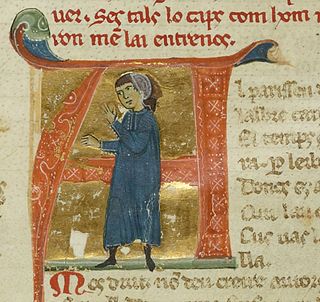
Peire Rogier was a twelfth-century Auvergnat troubadour and cathedral canon from Clermont. He left his cathedral to become a travelling minstrel before settling down for a time in Narbonne at the court of the Viscountess Ermengard. His life and career are known because his late thirteenth-century vida survives, as well as some of his works. The reliability of his vida, upon which all the details of his goings and comings are known, however, is not complete. According to it, he left the religious life to become a jongleur.
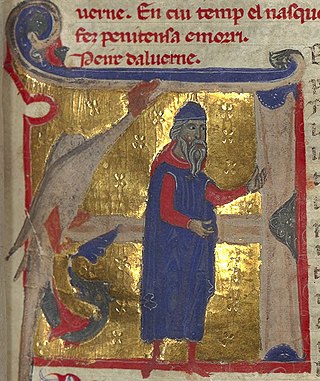
Peire d'Alvernhe or d'Alvernha was an Auvergnat troubadour with twenty-one or twenty-four surviving works. He composed in an "esoteric" and "formally complex" style known as the trobar clus. He stands out as the earliest troubadour mentioned by name in Dante's Divine Comedy.
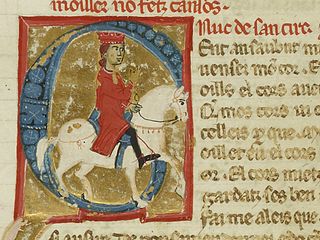
Uc de Saint Circ or Hugues (Hugh) de Saint Circq was a troubadour from Quercy. Uc is perhaps most significant to modern historians as the probable author of several vidas and razos of other troubadours, though only one of Bernart de Ventadorn exists under his name. Forty-four of his songs, including fifteen cansos and only three canso melodies, have survived, along with a didactic manual entitled Ensenhamen d'onor. According to William E. Burgwinkle, as "poet, biographer, literary historian, and mythographer, Uc must be accorded his rightful place as the 'inventor' (trobador) of 'troubadour poetry' and the idealogical trappings with which it came to be associated."
Grimoart(z) Gausmar(s) was a Gascon troubadour of the third quarter of the twelfth century. The sole source of information about his life comes from a satire of Peire d'Alvernhe, which mentions that Grimoart was a knight and jongleur. Only one known poem by Grimoart has survived. The poet names himself in its last lines:

Peire Raimon de Tolosa was a troubadour from the merchant class of Toulouse. He is variously referred to as lo Viellz and lo Gros, though these are thought by some to refer to two different persons. On the other hand, lo Viellz could refer to his being of an early generation of troubadours. Eighteen of Peire Ramon's poems survive, one canso with a melody.
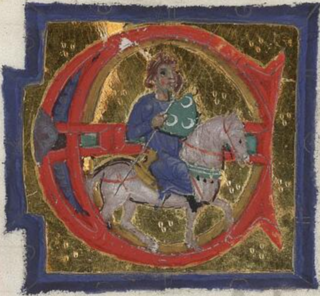
Rambertino di Guido Buvalelli, a Bolognese judge, statesman, diplomat, and poet, was the earliest of the podestà-troubadours of thirteenth-century Lombardy. He served at one time or other as podestà of Brescia, Milan, Parma, Mantua, Genoa, and Verona. Ten of his Occitan poems survive, but none with an accompanying melody. He is usually regarded as the first native Italian troubadour, though Cossezen and Peire de la Caravana may precede him. His reputation has secured a street named in his honour in his birthplace: the Via Buvalelli Rambertino in Bologna.

Peire Guilhem de Luserna was a Piedmontese troubadour.

Bernart de Venzac was an obscure troubadour from Venzac near Rodez in the Rouergue. He wrote in the Marcabrunian style, leaving behind five moralising pieces and one religious alba. Two of his works were confused by copyists with those of Marcabru in some manuscripts.
Gavaudan was a troubadour and hired soldier at the courts of both Raymond V and Raymond VI of Toulouse and later on in Castile. He was from Gévaudan, as his name implies. He wrote moralising lyrics, either religious or political, and ten of his works survive, including five sirventes, two pastorelas, one canso, one planh for an anonymous domna (lady), and one Crusade song. He is sometimes clumped in a primitive Marcabrunian "school" of poetry alongside Bernart Marti, Bernart de Venzac, and Peire d'Alvernhe. He developed a hermetic style, combining elements of the trobar ric and trobar clus.

Peire Bremon lo Tort was a troubadour from the Viennois. Though only two of his pieces survive, his poetry is characterised by Francoprovençalisms. According to his short vida, he was "honoured by all the notable men."
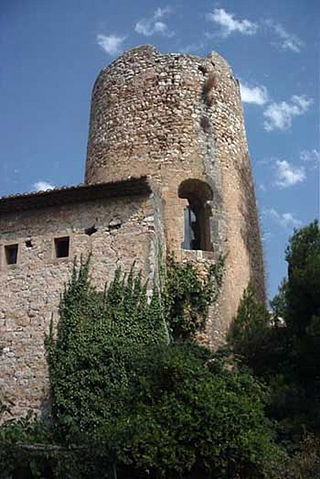
Guillem de Ribes (c. 1140 – c. 1220) was a Catalan nobleman and troubadour, that is, a composer of music and lyric verse in the Old Occitan language. None of his works survive and he is known as a troubadour only from a single reference to him in a song by another troubadour
Pere de Montsó, also Peire de Monzo(n), was an Aragonese troubadour, though none of his compositions survive. He was probably from Monzón near the border with Catalonia, but he may have hailed from Monzón de Campos in Castile, as Ramón Menéndez Pidal believed. He is the subject of the eighth stanza of a famous satire of twelve troubadours by Peire d'Alvernhe. This stanza has different readings:
Gonzalo Ruiz or Rodríguez was the feudal lord of La Bureba throughout much of the mid-twelfth century. He held important positions at the courts of successive Castilian monarchs and guarded the frontier with Navarre, to whose Jiménez rulers he was related. He was a cultured man, with connexions to at least one, possibly two, troubadours. He may have written poetry himself, though in what language is not known.
References
- Bertoni, Giulio. I Trovatori d'Italia: Biografie, testi, tradizioni, note. Rome: Società Multigrafica Editrice Somu, 1967 [1915].